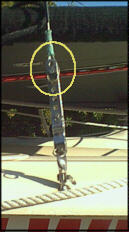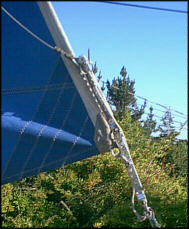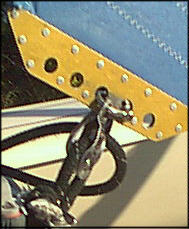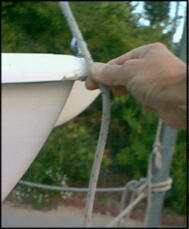

|
Raking the Mast on a Hobie 16 Increasing Upwind Performance By Bill Mattson |
|
So you want to race that older model Hobie 16? One of the first tuning options you need to
consider is mast rake, or tilting your mast towards the rear of the boat. Mast rake will
move the center of effort aft towards the rudders, and help your boat point better. Since
most of the time on the race course is beating upwind, that's where you want the boat to
peform it's best.
It would seem that the only thing involved in raking your mast is to shorten the shrouds and lengthen the forestay. As it turns out, these are only the first steps in the project. Once you rake your mast, you change the geometry of the boat in a way that effects a few other components. For now, let's take it one step at a time. The following steps were required on a 1981 Hobie 16. Your results may vary on newer boats. The costs are based on 2001 estimates. 1. Shrouds and Forestay |
|
We replaced the shrouds on our '81 Hobie 16 with stock Hobie 17 shrouds, which are 19' long.
They were installed at the 2nd hole from the top on the chainplates. Cost: $50 |

|
|
To lengthen the forestay, simply ad an additional chainplate. When you rig your jib, attach it to the lower chainplate. Cost: $8 Total so far: $58 |

|

|
|
2. Main Blocks |
|
If you have the old Seaway "stacked" blocks for your main sheet, you won't be able to use
them anymore. (These are the blocks with 3 sets of pulleys). Since you raked your mast back,
you have lowered the boom. It is now so low that there is not room for the old Seaways when the main
is completely sheeted. The solution is a set of Harken low-profile main blocks. Simply remove
your Seaways and install the new blocks. Cost: $220 Total so far: $278 Note: If you're short on cash, See Roy Tally's Tech Tip on converting your old Seaways to low-profile. Slick!! |

|
|
3. Jib Blocks |
|
If you have the old jib block traveler cars with the springs, you MAY not be able to sheet your jib all
the way, since the clew of the jib sail will be so close to the block. In this case, you'll
need to lower profile jib traveler cars. A nice solution is to upgrade the whole traveler system
with a new control kit. (See www.murrays.com, parts #01-3120, #25-3010, and #07-1162.) Your crew
will also appreciate not having to crawl down the leeward side to fumble with the old peg adjusters.
Cost: $200 Total so far: $478 |

|
|
Even with the low profile jib travelers, you still may be tight on space. To squeeze just a bit more, you can run the shackle on your jib clew plate through 2 of the plate holes to gain another 1/2" or so. Cost $0 (Finally... A freebie) Total Project: $478 |

|
| 4. Measuring Mast Rake |
|
To measure the amount of mast rake, rig your boat completely. Take the main halyard and pull it from the top of the mast to the tip of one of the bows. Hold the rope with a thumb and forefinger at the point where the line touches the bow, With this hold as a mark, take the line to the stern. |

|

|
|
The point where the line
touched the bow should be 8 to 12 inches below the stern. This distance can
be altered by changing the shroud positions at the chainplates.
5. Raking Rudders Another interesting effect of raking your mast is that you will have an increased weather helm (the tiller will be difficult to hold as the boat tries to round up into the wind). Depending upon the amount of mast rake, the weather helm may be intolerable. For an explanation of weather helm and why it occurs, see Kim Miller's excellent articles: What's All This about Weather Helm What's All This About Weather Helm (Part 2) To correct the "tiller tug", you will need to rake your rudders under the boat a bit. Unless you have adjustable rudders (which are not original equipment on older boats), you will need to remove your rudders, fill the holes with epoxy, then redrill them. For a complete guide to doing this, see: Raking Rudders And while we're at it, let's go nuts and tune the rudders using David Hall's excellent article: Towards the No-Slop Rudder Note that after raking my mast, I did sail the boat for quite a while without any rudder adjustment. It can be done, but may give you a sore arm after a while. Also, you may be able to get by without the new jib travelers, if you run the shrouds higher on the chainplates. But to get the full benefit of the raking, you really have to finish the whole project. That's it! Now you're ready to run with the big boys! Now get out there and win! |
|
Bill Mattson mattson@earthlink.net Back to Features |